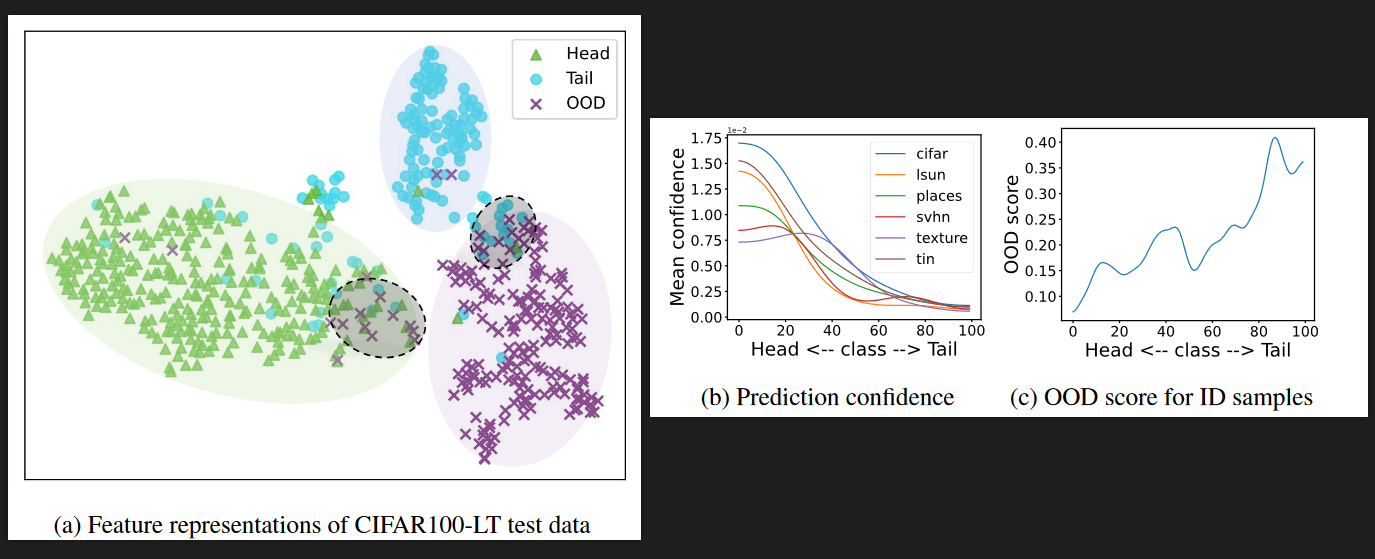[AAAI2024]Out-of-Distribution Detection in Long-Tailed Recognition with Calibrated Outlier Class Learning
这篇文章设置的问题是:考虑长尾分布的训练集下,对测试集上的OOD样本进行检测。作者在训练集中引入了open set样本学习异常表征,以OCL(Outlier Class Learn)为baseline,训练时引入prototype方法,推理时对logits进行调整校准。
问题背景
DNNs会把OOD(out-of-distribution)样本误分类为ID(in-distribution)样本,训练集为长尾分布时,问题被进一步加剧,表现为:
- OOD样本以较高的置信度分为head classes。
- tail classes样本比head classes样本更容易被误分类为OOD样本。

Related Work
平衡数据集下的OOD检测
- 事后方法(post hoc methods):在推理阶段,设计新的OOD打分函数。
- 使用辅助的open set数据集,最早由[2]提出的OE(outlier exposure)损失函数,对于open set样本使用单独的损失函数。这里\(u\)表示基于均匀分布的OOD数据伪标签,与[3]中对于引入的open set打标签做法相似,详见此处。
长尾学习下的OOD检测
- 使用辅助的open set数据集使得模型对OOD检测更robust,[3]的问题设置主要针对长尾学习,但在实验中也提到了OOD检测。
- 将OOD的预测概率拟合进长尾分布,但在长尾学习中很难获取准确的OOD分布。因此作者使用OCL(outlier class learning)作为baseline。这里\(\tilde{y}=k+1\),k表示ID类的数量。
作者在实验中发现,一般的OOD检测任务中,OE表现优于OCL,但在长尾学习下,OCL表现优于OE。这是因为设置open set样本的先验概率为均匀分布,在长尾设置下并不合理。因此选用OCL为baseline。但需要考虑两个问题:OOD被误分类head classes;tail classes样本更容易被误分类为OOD。
Method
整体的框架如图所示,在训练阶段引入Debiased large margin learning,推理阶段引入Outlier-class-aware logit calibration。

训练阶段的Debiased large margin learning
解决“tail classes样本更容易被误分类为OOD”:
之前的工作利用各种增强将尾部样本推离OOD样本,但由于尾部类别的大小有限,学习不到两者间区分明显的表征。
为了解决这个问题,作者使用一个可学习的prototype代表一个tail class,同类的样本拉近prototype,并推离其他尾部类prototype和OOD样本,利用尾部原型来增加尾部类表示的存在,有助于减少模型对OOD样本的偏差。原型表示为\(\mathcal{M}\in\mathbb{R}^{N\times D}\)。N表示可学习参数数量,D表示特征维度,优化目标为:
这里P与batch内的开集样本相关,\(P(x)=\sum_{\hat{x}\in\mathcal{O}}exp(z(x)z(\hat{x})^\intercal/t)\);m表示为\(\mathcal{M}\)内的尾部类原型,z表示为logits,t表示为温度参数。
形式上,与moco的损失函数相同:\(\mathcal{L}_q=-\log\frac{\exp(q\cdot k_+/\tau)}{\sum_{i=0}^K\exp(q\cdot k_i/\tau)}\)。
解决“OOD被误分类head classes”:
由于长尾数据集中,head classes样本数量极大,OOD样本很容易被归类为head classes。此处,作者引入了对比学习:选择1个OOD样本为anchor,随机挑选一个head classes样本为negative samples(\(x^n\))和另一个OOD样本为positive samples(\(x^p\)),优化目标为:
其中margin为超参数,最后的损失函数定义为:
推理阶段的Outlier-class-aware logit calibration
推理阶段时,head classes样本比tail classes和OOD有着更高的预测置信度,为了解决这个问题(尽可能得多筛选出OOD样本),作者提出了Outlier-class-aware logit calibration:
其中\(n_i\)为闭集类的样本数占闭集类总样本数:\(n_i=\frac{N_i}{N_1+N_2+\cdots+N_k}\),对于异常类k+1类,认为ID分类和OOD检测同样重要,因此设置为\(n_{k+1}=1\)。这样,降低头类概率,增加尾类概率,同时考虑OOD样本对预测的影响。
实验设置
训练集加入了open set样本,但加入的open set样本与测试集的OOD样本无交集。以cifar10为例,训练集的opens set辅助数据集为TinyImages 80M;测试集的OOD数据集分别加入数据集Texture、SVHN、CIFAR100、Tiny ImageNet、LSUN、Place365,并分别做测试,统计AUC、AP-in、AP-out、FPR,也就是测试了6次,如果测试集加入的OOD类与训练集样本的类有重合,需要把它剔除。
参考文献
- Miao, Wenjun, et al. "Out-of-distribution detection in long-tailed recognition with calibrated outlier class learning." Proceedings of the AAAI Conference on Artificial Intelligence. Vol. 38. No. 5. 2024.
- Hendrycks, Dan, Mantas Mazeika, and Thomas Dietterich. "Deep Anomaly Detection with Outlier Exposure." International Conference on Learning Representations. 2018.
- Wei, Hongxin, et al. "Open-sampling: Exploring out-of-distribution data for re-balancing long-tailed datasets." International Conference on Machine Learning. PMLR, 2022.



